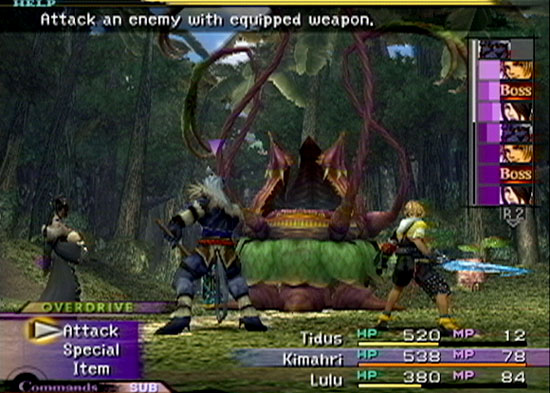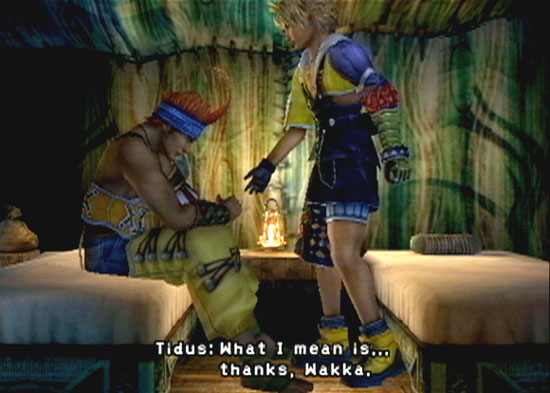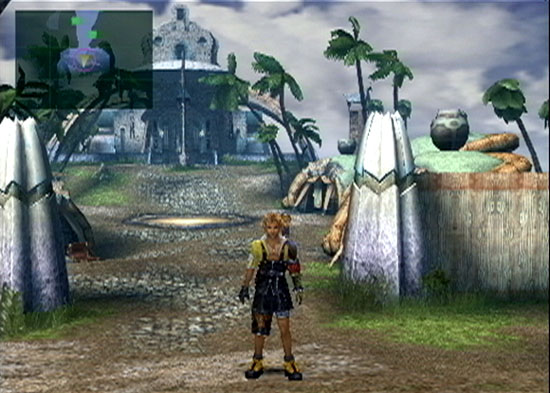 |
Final Fantasy X - Retroview
|  |
Linear Form
By: Michael Beckett
| Review Breakdown | | Battle System |
6
| | Interface |
8
| | Music & Sound |
7
| | Originality |
6
| | Story & Plot |
8
| | Localization |
8
| | Replay Value |
2
| | Visuals |
9
| | Difficulty |
Very Easy
| | Completion Time |
25-60 Hours
| | | Overall |

|
 | |
Combat changed a great deal from FFIX to FFX. |
|
Being one of the best-loved and most-criticized game series of all time, reviews of new Final Fantasy games tend to either gush or trash. Final Fantasy X, released in the early days of the PS2, deserves a little of both. Though Final Fantasy X's quality is quite high, the game in general comes off feeling very forced and linear. Granted that console RPGs are never particularly open-ended, but Final Fantasy X leaves a player very little choice in anything.
Things start to feel a bit forced in the combat system right after you acquire more than three characters, which is the combat party limit. Characters can be switched in and out of combat with the flick of the R1 button, but certain enemies can only be defeated by certain characters. Flans, for instance, are only vulnerable to Lulu's magic, while the more heavily armored creatures can be felled only by Auron's piercing blade. Certain enemies are too agile for Auron to hit, so Wakka or Tidus, with their higher accuracy, must be called in. Points to the battle designer for including the whole party in combat, but same points taken away for destroying any semblance of choice on the player's part.
There are some major differences between Final Fantasy X's combat system and those of the earlier Final Fantasies. Gone is the ATB of days past, replaced by a turn-based system replete with a meter on the right side of the screen to show you whose turn comes when. Perhaps that was spoiling the player, perhaps not, but it certainly makes things easier to plan. Still, it's not as if much strategy is required to defeat normal foes, or even most bosses. Like its predecessors, the strategies used in Final Fantasy X are mostly limited to See Foe, Hit Foe, Collect EXP and Gil. Character development is handled by the Sphere Grid, a circular collection of nodes which can be activated by specific Spheres collected during your travels. These nodes can increase stats, earn new abilities, or even share traits among characters. The Sphere Grid is an interesting and original way to increase character abilities without relying too heavily on levels and EXP, and is executed well for the most part. Towards the end of the game, once characters start finishing their sections of the Sphere Grid, combat becomes a bit more interesting. I just wish finding my way around the Grid wasn't such a tribulation.
 | |
Tidus is a charismatic little whiner. |
The directional pad is used to move the cursor around the Sphere Grid, but since the nodes are arranged in a circular pattern, it's never quite clear if pressing up on the control pad is going to lead you to the node directly above you, to the closest node above you along the path you're on, or what. The use of the left joystick to individually select nodes does help a bit, but the 'sticky' quality that causes it to be attracted to every single node from a certain distance is quite obnoxious.
On the field, the camera angles tend to change unexpectedly. Tidus will keep running in the direction you were originally pointing him in, giving you time to readjust. The attention shown to the attitude and instincts of the player shows good some good foresight on the part of the programmers. The camera angles themselves can be a bit obnoxious at times, but never to the point where you would need control of the camera yourself. Some of the sights to be seen in Spira are quite wonderful, and the camera gets the honor of showing you the best bits.
Traditionally, music composed for the Final Fantasy series has always been done by Nobuo Uematsu. In Final Fantasy X, for whatever reason, Squaresoft decided it was time for a change. Mr. Uematsu still composed some of the music, such as the main theme, Suteki Da Ne (Isn't it Wonderful), but two newcomers were called in - Junya Nakano, and Masashi Sugawara. The musical styles mesh well, to the point where I couldn't easily hear which tracks were composed by whom. The soundtrack itself is quite good, with tracks like "Otherworld" and "Hymn of the Fayth" sure to garner a lot of attention amongst fan remixers.
The voice acting seemed a bit spotty. While John DiMaggio, Matt McKenzie and Paula Tiso as Wakka, Auron and Lulu stand out as the best of the bunch, James Arnold Taylor and Tara Strong as Tidus and Rikku turn out fine performances as well. The main problem with the voice acting has to do with Squaresoft's decision not to re-sync the lip movements with the English voices. Struggling to fit words to lips, voice actors stumble over pauses and crash head-first into closed mouths where open ones should have been. Yuna is the biggest victim of this, compounded further by the fact that during much of the game, Yuna speaks hesitantly. It's fitting for a young girl who is as unsure of herself as Yuna obviously is, it just doesn't help the voice actor any.
 | |
The setting of Spira is that of an incredibly beautiful tropical island chain. |
Much of the themes in the plot of Final Fantasy X are purposely recycled from earlier Final Fantasies, as are a great number of abilities, moves and even characters. At big number X, the series still manages to find some sense of freshness, but the reuse of older themes is beginning to get stale. From the outset, it's obvious that Yuna will succeed. It's obvious that she and Tidus will fall in love. The large majority of plot points are not as blatant, which is certainly a good sign for Squaresoft's long-term staying power. On the non-plot parts of the game, things seem fairly original or at least well thought out.
The story behind Final Fantasy X has to do not only with the normal Final Fantasy topics of love, friendship and saving the world, but also with the relatively unexplored topic of sacrifice. Squaresoft even throws in a bit of a messiah theme with Yuna, a girl fated to sacrifice herself to save the world. Yuna's story, intertwined with that of Tidus, provides for a very entertaining, even touching, tale. All of the characters go through remarkable changes during the progress of the story, and each unique personality is sympathetic and likeable. Tidus is a bit of a whiner, but he grows out of it - much to my relief. On the whole, the story is well written and nearly cliché-proof. Give credit to Mr. Nojima, the scenario writer, for coming up with a story worth hearing.
There are very few problems with the localization, but the biggest one seems to be the decision not to re-sync lips to voices. This problem bothered me throughout the game and really detracted from my enjoyment of the otherwise fine voice acting. The stutters and blank pauses were truly irritating. As for the text of the story, there seems to be no noticeable errors or speeches that feel unnatural.
As I've said, Final Fantasy X is quite linear. The few side quests contained in Spira's story have mainly to do with unlocking ultimate weapons. Unfortunately, these side quests are nigh impossible, tedious and time consuming. And unnecessary to boot; the game can be quite easily completed with self-made or dropped weaponry. Since every character, or nearly every character, participates in battle, the replay value drops further; there is no reason to replay to try out characters you didn't use before. Really, the only reason to replay Final Fantasy X would be to hear the story again. Not a bad goal, but not one many RPGamers are going to go for.
As with many Final Fantasies, there is a wide discrepancy between field graphics and Squaresoft's lauded FMVs. In Final Fantasy X, this is limited mainly to making the characters look somewhat more Asian in FMVs than they do on the field. The normal gulf between field and combat models has been all but eliminated; characters look pretty much the same whether on the field or in combat. I did notice a fair amount of breakthrough (when a polygon can be seen through the one above it, creating the illusion that, for instance, Auron's leg is going through his coat), which can certainly cause problems. In general, models are very detailed, character design is quite good, and the world of Spira is quite beautiful. The art director deserves some serious credit for a job very, very well done. Styles of clothing, architecture and even weaponry are all well represented in Final Fantasy X.
Final Fantasy X can be either a very long game or a very short one. Without the completely unnecessary side quests, Final Fantasy X can be completed in around twenty-five hours. However, with catching monsters, collecting celestial weapons and the seals to unlock them, expect to play for two to three times as long. And except for a few of the optional bosses, Final Fantasy X is very, very easy.
Final Fantasy X is a high-quality game that deserves some respect as a uniquely powerful narrative. However, hobbled by a painfully linear design and a few lazy localization choices, Final Fantasy X seems far too restrictive to truly be a classic. This is certainly not the same thing as saying the game isn't enjoyable. On the contrary, Final Fantasy X is a testament to Squaresoft's ability to create explosively emotional works of video art, and a witness to its place as a leader at the forefront of RPGs at this crucial stage in the medium's development. I can only hope that this linear form does not become standard for other RPGs, because while it might have worked for Final Fantasy X, it wouldn't be a good thing for console RPGs to become even more linear.
|







